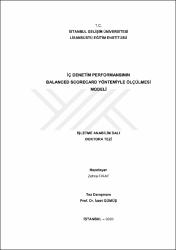İç denetim performansının balanced scorecard yöntemiyle ölçülmesi modeli
Özet
İç denetim faaliyeti; kurumun yönetişim, risk yönetimi ve kontrol süreçlerinin etkinliğini bağımsız ve tarafsız olarak denetleyerek, kurumsal işleyişin niteliği hakkında fikir sahibi olunmasını sağlar ve problem görülen alanları tespit ederek, iyileştirme önerilerinde bulunur. Kurumların geleceklerine dair perspektif oluşturmalarına yardımcı olur. Dolayısıyla kurumlar için yadsınamaz derecede önemli bir rolü vardır. İç denetim faaliyetinin işlevsel ve etkin şekilde gerçekleştirilmesi bu önemli rolün yerine getirilmesi anlamına gelir. Tezin nihai amacı; iç denetimin performansının ölçülmesini sağlayan, genel geçerliliği olan bir model oluşturmak ve iç denetimin kurum içindeki rolünün önemini ispatlayarak farkındalığını arttırmaktır. İç denetim performans ölçümünün sistematik hale getirilerek standardizasyonunun sağlanması iddiası ile oluşturulan model, tüm kurum ve kuruluşlar açısından kullanılabilir olması ile literatürdeki ilk örnektir. İç denetim performans ölçümünde, hangi boyutların kapsanması ve hangi performans göstergelerinin kullanılması gerektiği belirlenmiş; bu boyutların ve performans göstergelerinin AHP analizi aracılığıyla ağırlıklandırılması yapılmış ve bir Balanced Scorecard performans modeli oluşturulmuştur. Bu çalışma sonucunda, iç denetim performansının somut verilerle ölçülebildiği, yönetim kademelerine net ve kolay anlaşılır, tek bir rapor olarak sunulabilecek bir model kurulmuştur. Bu model aracılığı ile iç denetim etkinliğinin, üst yönetim kademeleri ve ilgili paydaşlarca anlaşılması ve farkındalığının arttırılması beklenmektedir. Bu çalışmada, iç denetim faaliyetinin performans ölçümünde Balanced Scorecard (Dengeli Puan Kartı) yöntemi tercih edilerek; kurumsal süreçlere etki eden niceliksel kriterlerin yanı sıra, niteliksel kriterlerin de değerlendirme sürecine dahil edilmesi sağlanmıştır. Böylece daha kapsamlı ve gerçek sonuçlara ulaşılması hedeflenmiştir. Birbirleri ile bağlantılı ve bir hiyerarşiye sahip performans boyutlarından oluşan model, aralarındaki ilişkileri ve etkileri test edilmiş ve farklı çalışmalarda kabul gömüş, kritik başarı faktörlerini ve değerlerinin ölçülmesini sağlayan performans göstergelerini içermektedir. Belirlenen performans göstergelerinin kurumsal hedeflere göre gerçekleşen değerleri, KBF(kritik başarı faktörleri) nin ağırlıklarına göre hesaplanarak iç denetim performans düzeyi ortaya konmaktadır. Tezin ilk üç bölümünde çoğunlukla literatür bilgilerinden faydalanılmış, kavramsal içeriklere ve birbirleriyle olan ilişkilerine yer verilmiştir. Sonraki iki bölümde, iç denetim performansının ölçülmesinde kullanılacak yöntemin açıklaması ile beraber iç denetim faaliyetinin performans ölçüm modeli çerçevesi oluşturulmuş ve performans sürecinde izlenecek yol haritası çizilmiştir. Altıncı bölümde modelde kullanılacak KBF (kritik başarı faktörleri) ve performans göstergeleri belirlenmiş ve açıklanmış sonrasında da istatistiki yöntemlerden faydalanılarak modelin uygulaması ve analizi yapılmıştır. Internal audit activity, provides ideas about the quality of corporate operations by auditing the effectiveness of the governance, risk management and controlling processes independently and objectively, and suggests improvements after identifying the areas where problems are encountered. It helps organizations to create a perspective about the future. Therefore, it plays an undeniably important role for organizations. Performing the internal audit activity functionally and effectively means fulfilling this important role. Main purposes of the thesis are creating a modal to measure the internal audit performance and increasing awareness by proving the importance of its role for organizations. The model which is created for ensuring an internal audit performance standardization by systematizing it, is the first of its kind in the literature as it can be used for all institutions and organizations. It is determined which dimensions should be covered and which performance indicators should be used for internal audit performance measurement. As a result of this study, a model has been established in which the internal audit performance can be measured with concrete data and can be presented to management level as a single report in a clear and an understandable form. Through this model, it is expected that the internal audit activity will be known and understood by top management level and affiliated stakeholders. In this study, Balanced Scorecard method is preferred for the performance measurement of the internal audit activity, so as well as the quantitative criteria affecting the corporate processes, qualitative criteria are also included in the evaluation process. Therefore, it is aimed to reach more comprehensive and actual results. The model, which consists of performance dimensions that are connected with each other and have a hierarchy, includes the performance indicators as their relations and effects have been tested and accepted in different studies and that measure the critical success factors and values. Actual internal audit performance value is found by calculating the change of the specific objectives of measurable performance indicators according to weights of the KBF (critical success factors). In the first three chapters of the thesis, literature information is used, conceptual contents and their relations with each other are included. In the next two sections, the performance measurement model framework of the internal audit activity is established with the description of the method to be used for internal audit performance measurement and a roadmap for the performance process is drawn. In the sixth section, KBF and performance indicators which will be used in the model are determined and explained; thereafter the application and analysis of the model is performed with statistical methods.
Bağlantı
https://hdl.handle.net/11363/2443Koleksiyonlar
- Doktora Tezleri [60]
Aşağıdaki lisans dosyası bu öğe ile ilişkilidir:


















